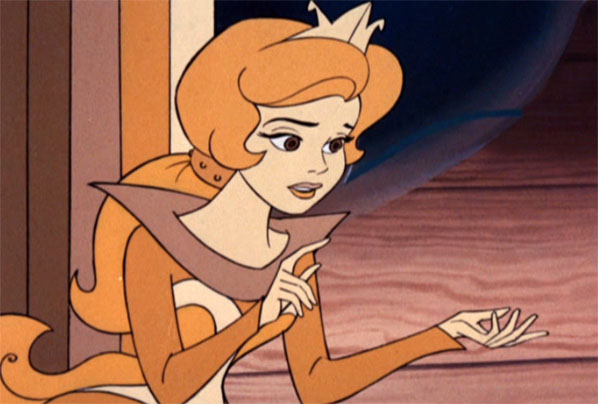
Singing for Princess Serena in 1967’s “Jack and the Beanstalk”
The film technique of “ghost singing” has been a practice in movies almost since the time they started to talk and sing. If for some reason the onscreen actor cannot provide the vocal requirements for a given piece of music, a professional vocalist dubs over the actor on the soundtrack. For many years these skilled performers were completely anonymous.
The most famous ghost singer in the history of entertainment was Peabody Award winner Marni Nixon. (To be sure, there have been plenty of other outstanding studio vocalists before and since, including Sally Stevens, whose superb book describes her life and art.) For years, Hollywood offscreen singers were not permitted to reveal their ghost singing, under legal penalty and the threat of “never working in this town again.”
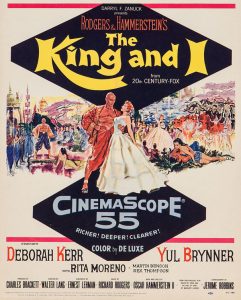 It took the remarkable Deborah Kerr to buck the system. Marni was assigned to sing for Kerr when she starred in the film version of Rodgers and Hammerstein’s The King and I. Kerr realized that making Marni a creative partner rather than a mystery would only improve the overall project. The two worked together in rehearsals, as the playback was heard, while each worked on their respective performances for the musical sequences. Kerr insisted that Marni be acknowledged as the singing part of the performing “whole,” just as camera work, lighting, costumes, make-up, editing, and scoring were crucial.
It took the remarkable Deborah Kerr to buck the system. Marni was assigned to sing for Kerr when she starred in the film version of Rodgers and Hammerstein’s The King and I. Kerr realized that making Marni a creative partner rather than a mystery would only improve the overall project. The two worked together in rehearsals, as the playback was heard, while each worked on their respective performances for the musical sequences. Kerr insisted that Marni be acknowledged as the singing part of the performing “whole,” just as camera work, lighting, costumes, make-up, editing, and scoring were crucial.
In doing so, Kerr made it clear that dubbing was a great asset to the art of film, to be celebrated instead of concealed. Their speaking and singing performances in The King and I are so seamless that your author admits to not realizing it until years after the first viewing.
The pros and cons of using ghost singing, as opposed to allowing movie casts to sing for themselves, will probably be disputed as long as these productions are accessible. The key point is in relishing the ways film and TV entertain effectively. Motion pictures are a construct of visual and audio elements, many of which have little or no direct connection to what happens within the frame itself. The stars are usually miles from the locations where second unit crews film their characters in many long shots, especially in vehicles. Close-ups of hands are sometimes insert shots of hand models. Many of our favorite animation voice actors also do ADR (automatic dialogue replacement, also known as “looping”) to speak for actors when a scene is noisy, a voice is unclear, or foul language is removed for TV. Foley artists add footsteps – even dance steps – and sound effects that were not recorded on the set. Stand-ins, stunt actors and stunt doubles abound.
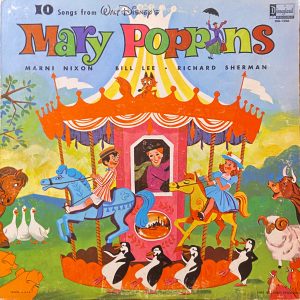 The beloved MGM classic Singin’ in the Rain offers a singular and simplified presentation of a non-singer being covered by a trained one. Behind the scenes it includes a dub within a dub, when Debbie Reynolds is depicted as singing for Jean Hagen and the vocalist is Betty Noyes (who sang “Baby Mine” in the original Dumbo). The same is true in 1961’s The Errand Boy, in which Kathleen Freeman is seen dubbing for an onscreen actor while an uncredited artist sings for her on the soundtrack.
The beloved MGM classic Singin’ in the Rain offers a singular and simplified presentation of a non-singer being covered by a trained one. Behind the scenes it includes a dub within a dub, when Debbie Reynolds is depicted as singing for Jean Hagen and the vocalist is Betty Noyes (who sang “Baby Mine” in the original Dumbo). The same is true in 1961’s The Errand Boy, in which Kathleen Freeman is seen dubbing for an onscreen actor while an uncredited artist sings for her on the soundtrack.
In taking the view of collaboration, Deborah Kerr and Marni Nixon changed the perception of offscreen vocals, though it was still being done both in secret and as public knowledge. By the time Marni sang for Natalie Wood (and a little bit for Rita Moreno) in the original film version of West Side Story and Audrey Hepburn in My Fair Lady, both films were such massive hits that Marni became a household name (and successfully arbitrated for royalties from Columbia Records for its best-selling West Side Story soundtrack album).
Marni did considerable work for Disney as well. Disneyland Records’ line of Mary Poppins releases included what they called “second casts,” which were studio vocalist versions in the place of the soundtracks with the stars. This allowed for more product on store shelves at varying prices. When Marni sang in place of Julie Andrews on Disneyland’s Ten Songs from Mary Poppins, division president Jimmy Johnson remarked that she “sounded more like Julie than Julie.”
However, Marni’s voice acting as the Geese in the “Jolly Holiday” sequence of the Poppins feature was uncredited, as was the work of Paul Frees, Thurl Ravenscroft, Bill Lee, Ginny Tyler, and Daws Butler. It was not unusual, since the likes of June Foray and Mel Blanc were also not credited for voice work on films like Divorce, American Style, and TV series like The Twilight Zone, Here’s Lucy, and Bewitched. Chuck Jones apologized to Thurl for the omission of his name in the Grinch credits. Like studio singing, looping is seldom credited to this day.
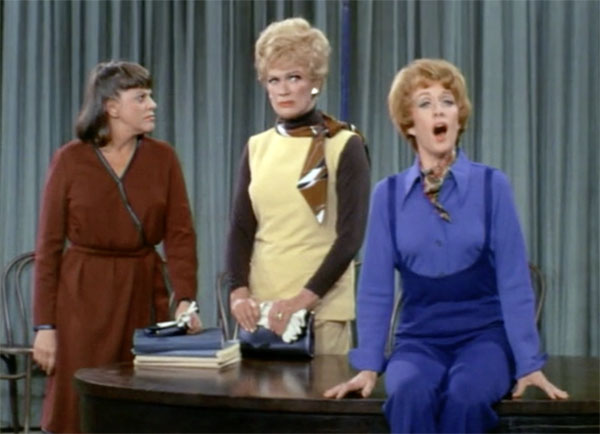
Kaye Ballard, Eve Arden, and Marni Nixon on The Mothers-in-Law sitcom
By the late sixties, Marni had become almost as famous by sight as by sound. One of her many TV appearances included the last episode of Desi Arnaz’s sitcom, The Mothers-in-Law with Eve Arden and Kaye Ballard. Hanna-Barbera credited her at the beginning of 1967’s Jack and the Beanstalk.
Premiering on Sunday, February 26, 1967 (pre-empting Walt Disney’s Wonderful World of Color), the special was the first primetime hour combining live-action and animation. The live-action was directed by and starring Gene Kelly, who had enjoyed great success with animation/live-action sequences created by Bill Hanna, Joe Barbera, and their artists for the MGM films Anchors Aweigh and Invitation to the Dance. In the special, Marni Nixon sang for Janet Waldo as Serena, while Janet also spoke offscreen for Jack’s mother, played onscreen by Marian McKnight (1957’s Miss America and wife of Land of the Giants star Gary Conway).
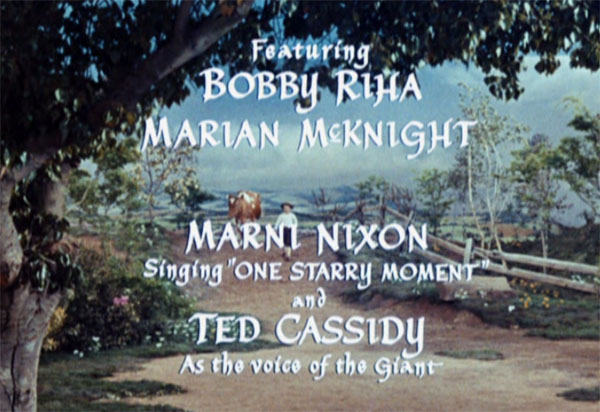
Jack and the Beanstalk credits with Marni’s name
The Hanna-Barbera features Charlotte’s Web and Heidi’s Song credited all the studio singers as well as the voice actors, very rare for the time. It wasn’t until Disney’s “renaissance” period in the nineties that singing voices became part of animated feature publicity and synergy. Lea Salonga sang for Linda Larkin and Brad Kane for Scott Weinger in Aladdin, the ghost singers even performed on the Academy Awards broadcast. Judy Kuhn sang for Irene Bedard in Pocahontas. In the original Mulan, the speaking voices were Ming Na Wen, B.D. Wong, and June Foray, while their singing voices were Lea Salonga, Donny Osmond, and Marni Nixon—who generated quite a bit of attention because of her astonishing history.
Other animation-related performances include Marni’s trills for composer/conductor Dennis Farnon on the delightfully offbeat 1956 RCA Victor LP, Magoo in Hi-Fi, specifically in the “Mother Magoo Suite.” We explored this album in this Animation Spin.
Perhaps Marni Nixon’s least-heralded animation singing occurred earlier in her career, when she was a member of such prestigious groups as The Roger Wagner Chorale, The Voices of Walter Schumann, and The Randy Van Horne Singers. The latter group can be heard singing the themes to Ruff and Reddy, The Huckleberry Hound Show, The Quick Draw McGraw Show, The Flintstones, The Jetsons, Top Cat, Touché Turtle, Wally Gator, and Lippy the Lion and Hardy Har Har, in addition to vocals within the shows. Thurl Ravenscroft was also in the group, along with B.J. Baker, who sang for Betty Rubble, Jane Jetson, and Wilma Flintstone.


 GREG EHRBAR is a freelance writer/producer for television, advertising, books, theme parks and stage. Greg has worked on content for such studios as Disney, Warner and Universal, with some of Hollywood’s biggest stars. His numerous books include Mouse Tracks: The Story of Walt Disney Records (with Tim Hollis). Visit
GREG EHRBAR is a freelance writer/producer for television, advertising, books, theme parks and stage. Greg has worked on content for such studios as Disney, Warner and Universal, with some of Hollywood’s biggest stars. His numerous books include Mouse Tracks: The Story of Walt Disney Records (with Tim Hollis). Visit 





















































Broadcaster Nick Clooney, brother of Rosemary and father of George, tells the story of how he went to Hollywood to break into pictures and managed to get an audition with Cecil B. DeMille. “Young man,” DeMille told him, “we like your face, and we like your voice, but we do not like the two of them together.” Sometimes the right face and the right voice for a particular role might belong to two different people, and it’s up to the filmmakers to combine them into a perfect whole.
If there really is anyone who opposes the use of ghost singers in film on principle, I invite them to try and sit through “At Long Last Love”, Tim Burton’s “Sweeney Todd”, and “La La Land”. All of these musicals have numerous flaws, but the rottenness of the leading actors’ singing performances is chief among them.
Thanks for identifying B. J. Baker; I always wondered who sang the Rockenshpeel song and, I presume, “Bill Bailey” for Wilma Flintstone. “I hope all you wives out there are taking notes!”
That’s why Deborah Kerr had the right idea. Why come across as an average singer to millions rather of making the ghost singing part of the total performance and acknowledging it as such?
One minor correction–in 1967, the “Wonderful World of Disney” was still billed as “Walt Disney’s Wonderful World of Color.” (I was there.) I also witnessed that initial showing of “Jack and the Beanstalk” and of course I loved every minute. It was my introduction to Gene Kelly–I was only 7 years old at the time and not as well versed in movie musicals as I would become by my early teens.
Marni Nixon was a resident of Seattle for much of her career, and thus I saw her on several occasions. She appeared in the Seattle Opera’s production of “La Pericole”. (The performance I saw was a school field trip consisting mostly of semi-rowdy teens who were viewing an opera in many cases for the first time. I will never forget how, when the audience reaction to a humorous bit went on for too long–Marni silenced the crowd with a wave of her hands and then went on with her aria. Those kids were startled into a profound respect and there were no more outbursts.) Later when I was in college I took my then-girlfriend to a performance downtown of “I Do! I Do!” in which Marni played the female lead. She was, of course, a delight.
Still later, I attended the filming of a local talk show in which Ms. Nixon was being interviewed. Her remarks were candid, a little risqué at times, but ever full of wit and charm. On that occasion I at long last got to meet her in person. I told her how much I appreciated her work, and she graciously signed my autograph book. No, I don’t know where that book is today, but at the time it was a prized possession.
If anyone wants an example of a star’s singing NOT being dubbed, the musical of “Mame” starring Lucille Ball is classic. Lucy insisted on doing her own singing throughout, and some of the vocal demands were clearly too much for her–although she does shine in the “Bosom Buddies” duet with Beatrice Arthur–the song was in a key that was not out of her range, and her comedy timing is better than Angela Lansbury’s on the same song–the one moment when Lucy outshone Angela. Of course, having Marni Nixon dub for Lucy wouldn’t have sounded right, but Lucy did have other talents such as Carole Cook who had dubbed her quite effectively on her TV show.
One more little anecdote is personal–in Napa, CA I directed a local production of “Fame” which required some singing on the part of several of the actors. But we had several performers who were shy about putting their singing voices on display. So those of us who didn’t mind singing got to “dub” the voices! I myself provided the singing voice for Professor Shorofsky. I can attest that it is a real kick to hear one’s own voice coming out of someone else’s mouth! There is nothing like it. I’m sure Marni Nixon derived some forms of satisfaction that went beyond screen credit or financial compensation.
A worthy tribute to a mostly unsung (pun intended) heroine of the stage and cinema. Thanks, Greg!
Let me just say that, to put it mildly, it’s very much a matter of opinion that Lucille Ball’s performance of “Bosom Buddies” outshone that of Angela Lansbury.
One correction: Marni Nixon did not dub Rita Moreno in West Side Story. Betty Noyes did–and only on the low parts of “A Boy Like That,” which were far outside Moreno’s range,
Betty Wand, who also dubbed Leslie Caron in “Gigi,” sang for Rita Moreno in “America” and “A Boy Like That/I Have a Love;” Marni Nixon sang for Rita Moreno in “Quintet,” for West Side Story. Marni told me that she also looped some of Natalie Wood’s dialogue in addition to her singing.
Marni dubbed Rita in the Quintet.
Indeed it was still World of Color, thanks! We will fix that in the text. The series did not change titles until tha fall of ’67. I remember all of us wondering what NBC would do without Walt to host the show. The answer was a new title and no host except for a few announcements.
Dallas McKennon also did some voices for Mary Poppins. He voiced the fox who delivered the line “The Redcoats are after me.”
Deborah Kerr and Marni Nixon are the best vocal match; only in the high notes, as in the lyric “I whistle a happy tune,” do you detect Marni. It’s hard to imagine anyone actually believing that voice coming out of Audrey Hepburn. (You may have heard Gerard Alessandrini’s parody “Dub Me” to the tune of “Show Me”: You need a star/ I have no voice/ You have no choice/ Dub me.)
Today they would have let these women do their own singing (as many of them did during filming, bringing Marni in afterward), digitally correcting the pitch here and there.
I’m afraid I have to disagree with Frederick about the “Bosom Buddies” number in “Mame”. By 1974 Lucy and Bea Arthur had ruined their respective singing voices through heavy smoking, and their phlegm-choked baritone duo comes across like a campy drag performance. Angela Lansbury in the title role was superior in every respect. If you want to hear how “Sweeney Todd” is supposed to be sung, stay away from the Tim Burton movie and listen to the original Broadway cast recording with Angela Lansbury and Len Cariou.
I remember “The Mothers-in-Law”! It was one of the few sitcoms of the late 1960s to be filmed in front of a live audience. The actors hollered all of their lines at the top of their lungs. Hilarious!
By no means did I mean to imply that Lucille Ball was the better singer. I was referring mainly to the spoken sections of the song in which Lucy’s comedy timing was able to shine. That said, there are many who would not even concede on my little point, and I totally respect that perspective. I am a huge fan of Angela Lansbury and no disparagement of her performance was intended. Nobody could surpass her in any of her roles. The movie should have been hers in the first place. At the very least, Lucy should have been more willing for her singing to be dubbed.
Certainly Lucy was perfectly willing to have all her close-ups in the film shot in soft-focus in order to mitigate her sallow, leathery smoker’s complexion.
Another enjoyable read, Greg. I hope to read about Gloria Wood’s career some day.
I didn’t know Marni Nixon was in the Randy Horne Singers. I think I got the B.J. Baker Jetsons ID for the Yowp blog years ago from you or Earl Kress. He identified Duke Mitchell for me on the Flintstones.
After Kerr publicly announced that Nixon had done her singing, the follwing verbal exchanged happened:
MN: My contract states nobody is to know I did your singing!
DK: Marni, how am I supposed to know what was in your contract?
This is recounted by Marni Nixon in her autobiography “I Sang all Night”. I may have gotten a couple of words wrong, though